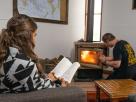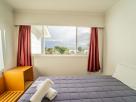Fiordland, Southland & Catlins Backpackers & Hostels
Currently 22 hostels in this area
Filter by Location: View All , Catlins (7), Fiordland (10), Southland (3), Stewart Island (2)

Giving Norway a run for its money, the Fiordland region in the South Island gives a geological masterclass in glacial architecture and desolate romance. There is something quite dauting and ominous about the sounds and mountains, a sense of nature lost and of being at the bottom of the world with nothing beneath you.
Much of this majestic World Heritage site is inaccessible to all but the most dedicated adventurers, but towns Te Anau and Manapouri can be the launchpad to brief excursions to the popular Milford Sound and Doubtful Sound. The region also features three of the Great Walks – Routeburn, Kepler and Milford Tracks – and is an absolute must for those looking for the wildest of wild camping. The purity of the lakes is equalled only by the clarity of the night sky, and the foreboding counterpoint of the bruising mountains creates and unforgettable experience.
Fiordland
Bordering on the outreaches of the Otago region, Te Anau and Manapouri both provide an excellent base from which to explore deeper into Fiordland. Te Anau at the north of the region serves as the gateway to Milford Sound, itself reached by an exciting drive up Highway 94, and a starting point for the Milford and Kepler Tracks.
Although a permanent population of less than two thousand ensures Te Anau is an intimate little town, it swells to several times that size during the high tourist season. Accordingly, it features extensive accommodation and restaurants which punch well above their weight. Local game such as venison and freshly caught trout is a regional specialty. Lake Te Anau is a beautiful setting on which to try kayaking and water skiing, and for a glimpse of some of the rare birds which inhabit the depths of Fiordland head for the Ta Anau bird sanctuary on the lakeshore.
Manapouri
This little village was once an unlikely and early hero of environmentalists when, in the 1950s, plans to flood Lake Manapouri for power station usage roused anger among New Zealanders, concerned about their unique natural habitat. And although the power station was eventually built (West Arm power station, the largest underground power generator in the Southern Hemisphere) it operates under strict control and observance for the surroundings. Much like Te Anau, Manpouri benefits greatly from tourism, and it is the main gateway to Doubtful Sound, Milford’s southern companion.
Doubtful is a more remote escape than Milford, accessible only by water taxi then an off-road drive which skirts around Mount George. Doubtful Sound itself is truly a forgotten land, the outskirts of New Zealand where seals and dolphins still own the open water. There is a sense you’re intruding on Nature’s privacy, and it’s an experience to be savoured. Manapouri is also an excellent base to explore some of the lesser travelled tracks around the Hunter, Wall and Townley Mountains. With dozens of peak exceeding 1500 metres, this is serious mountain country, and a testament to the reach of the Department of Conservation that even in such remote terrain they are still able to maintain an extensive hut network.
The Catlins
A relative latecomer to the New Zealand tourist boom, the Catlins is a sparsely populated and still wild area at the foot of the South Island. Far from the political manoeuvres taking place in the North Island during the 1800s, Maori prominence persisted in the region. It lacked the gold and other mining reserves found deeper into the Otago region, and the dense forest initially made it difficult to establish any farming.
The centres of Dunedin and Invercargill on either side of the Catlins remained the biggest economic draw in the region. Consequently, the area has remained relatively unspoiled, and the beautiful forests, waterfalls and coastline represent a New Zealand preserved. Many of the fern and tree species have their origins 80 million years ago when ancestral New Zealand was part of a super-continent, and coastline in particular is rich with fossils. It has a jurassic feel, and you can easily imagine pre-historic fauna roaming the plains and squirrelling around the forest beds.
With its nutrient dense waters, the coast is a hive of sea wildlife. Seals, dolphins, Yellow Eyed and Blue Penguins frequent the rocks and beaches. Similarly, the forests attract rare indigenous birds, such as the Kakariki, Titipounamu and the Mohua is native to the Catlins itself. The area is also home to iconic New Zealand totems such as the Nugget Point Lighthouse, also an excellent vantage point from which to view Elephant Seals and Yellow Eyed Penguins. Curio Bay is a precious gem, with its Petrified Forest and fossils dating back 170 million years.
Stewart Island
An ancient off-cut from the mainland, Stewart Island roams around fifty miles from the South Island, across the Foveaux Straight. Its English (or Scottish) name derives from one of the whaling ship officers who originally mapped the island, but its far more interesting Maori name Rakiura means “glowing skies”, and references the southern lights – the aurora australis.
Often referred to as New Zealand’s third island, Stewart Island is dominated by Rakiura National Park, roughly 85% of the area. Attempts to settle the island in the late eighteenth century were largely unsuccessful, and most of the land became conservation areas, before eventually achieving National Park status. The benefit of having remained largely untouched by European hands is that indigenous species have been left alone. Without the artificial predators such stoats and weasels found on the mainland, flightless birds in particular have continued to flourish, and Kakapo and Tokoeka (Stewart Island Kiwi) can even be seen during daylight.
Penguins and seals frequent the island’s inlets, and there is a Sea Lion colony at Port Pegasus. Because of its isolation, farming and mining interests were only ever inchoate, but its isolation is the very attribute which has enabled tourism to flourish. Walkers are drawn to the Rakiura Track, one of the nine Great Walks, and with crystal clear skies free from ambient lighting, the island has to be one of the best places in the world for wild camping and to watch the Southern Lights whist Kiwi scuttle by.
Ulva Island in the Paterson Inlet in a world famous bird sanctuary. It is strictly controlled, with no predators such as rats or wildcats, so flightless birds forage freely on the beachfront allowing you to achieve a high degree of intimacy with these beautiful creatures. Stewart Island is an absolute if you’re looking island loneliness, surrounded by the romance of nature and wildlife.





